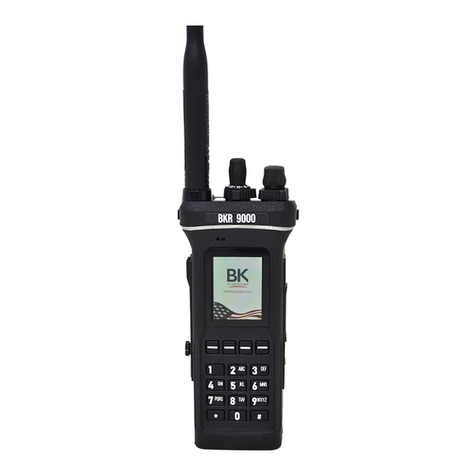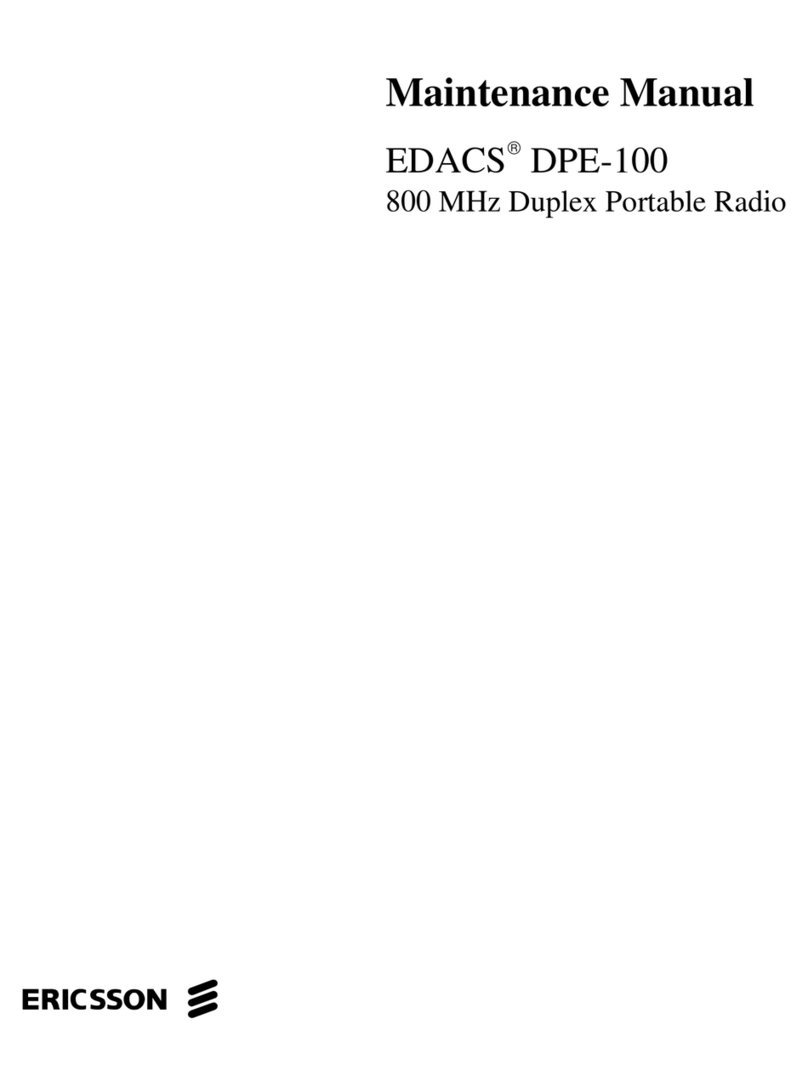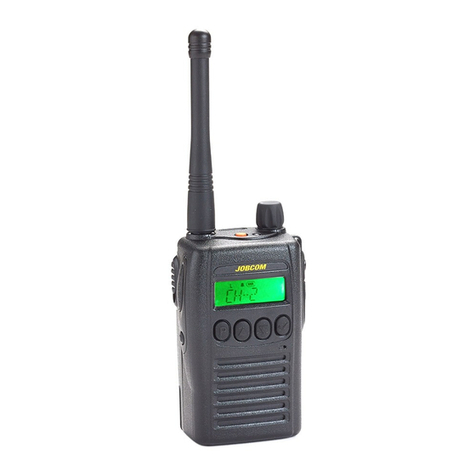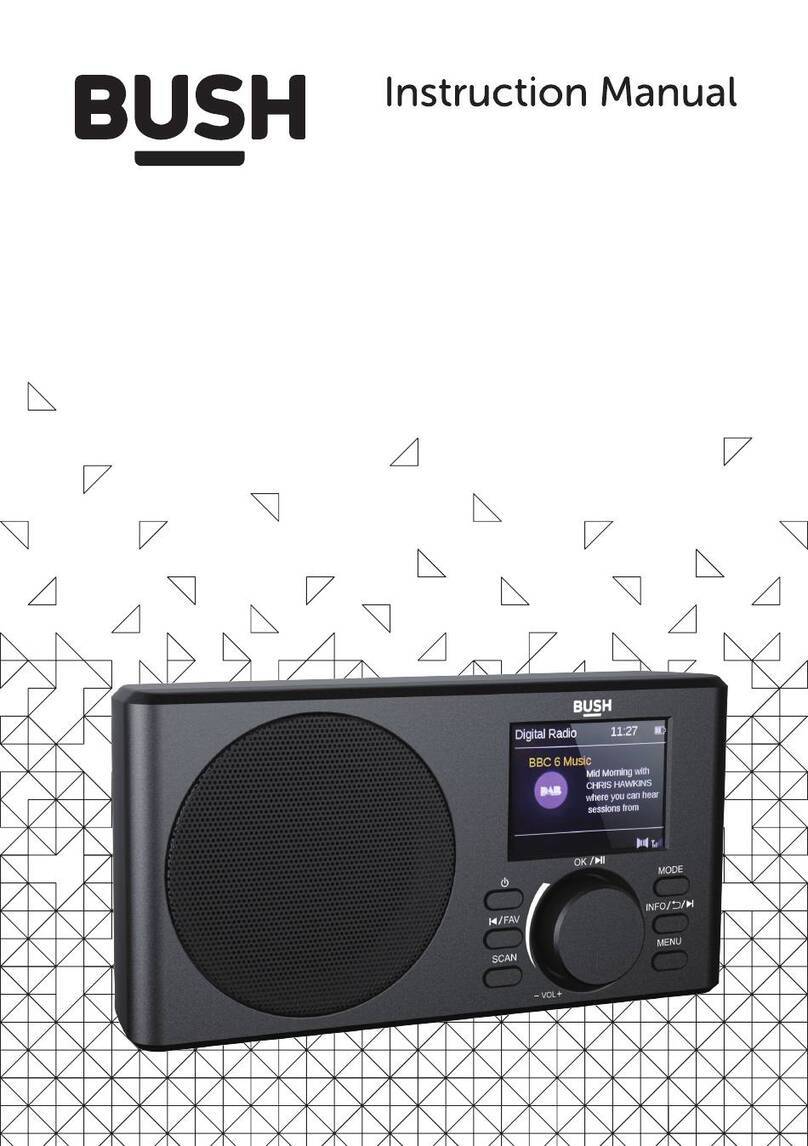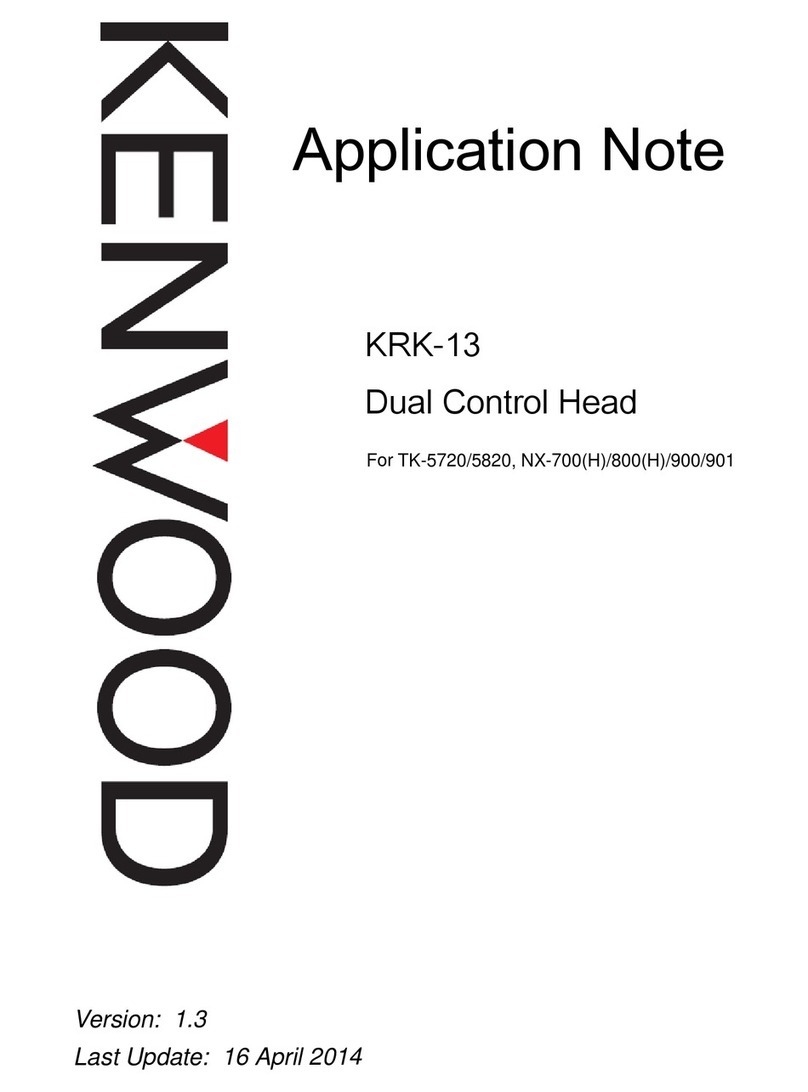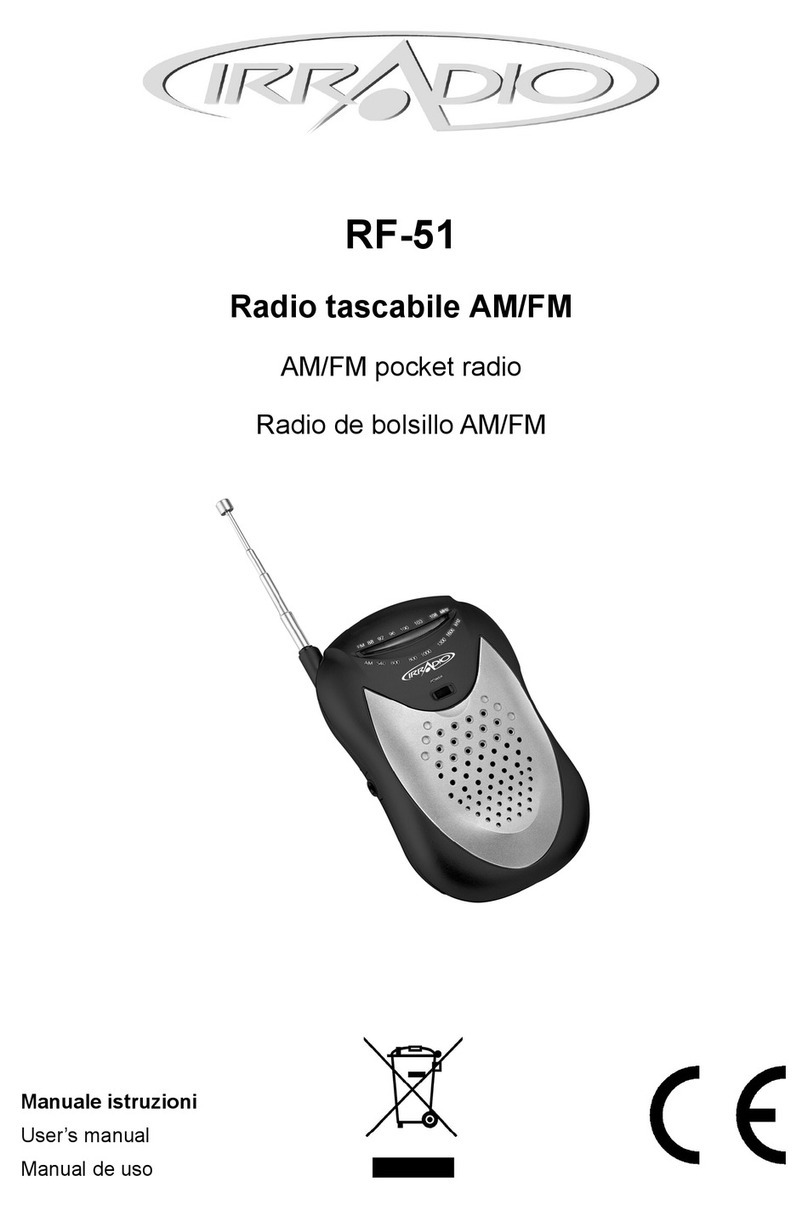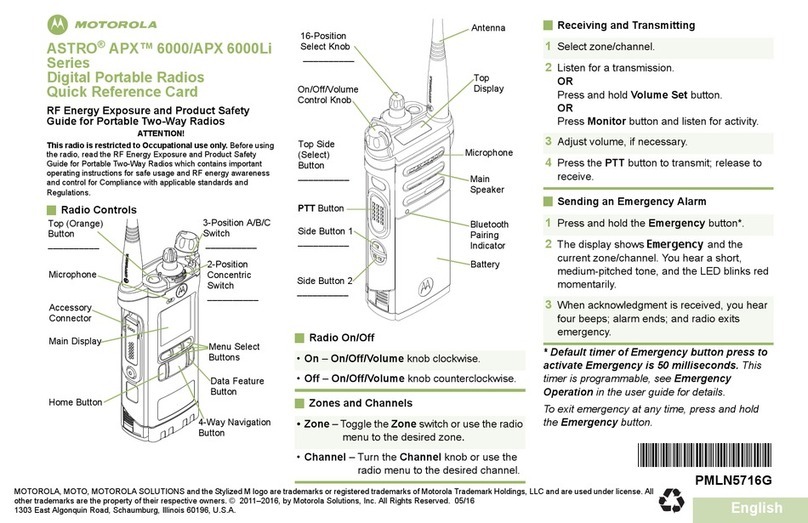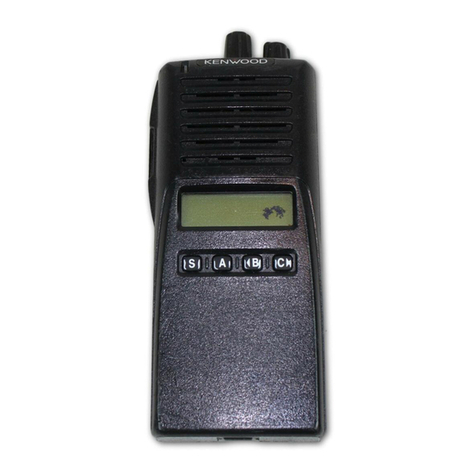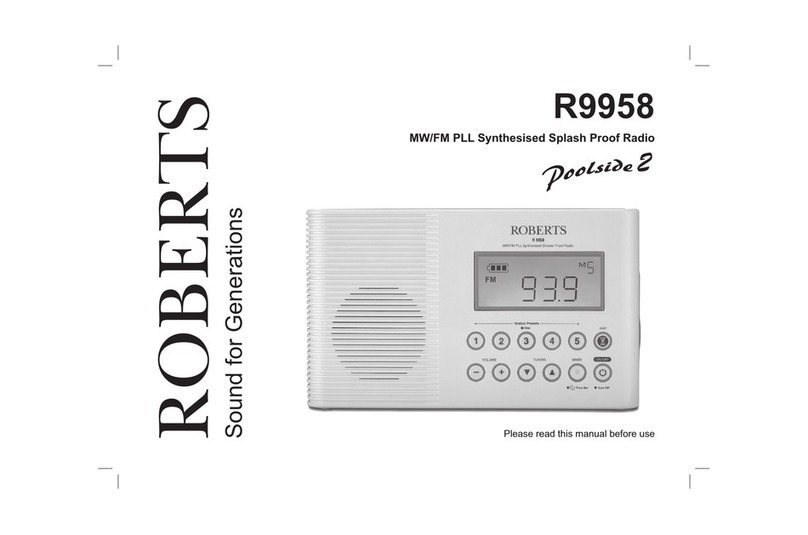BK TECHNOLOGIES BKR5000 User manual

Contents
Introduction.....................................................................................1
FCC Requirements .........................................................................1
Innovation, Science and Economic Development Canada
Compliance .....................................................................................2
Safety Precautions .........................................................................4
Information and Options ...............................................................7
Battery Installation and Removal .................................................8
Battery Care and Maintenance ....................................................9
Antenna Installation and Removal ...............................................9
Radio Controls..............................................................................10
LCD Display...................................................................................11
Status Indicators ..........................................................................11
Programmable Switch and Button Functions ...........................13
Options and Labels .......................................................................14
Channel/Zone Selection Options................................................17
Channel/Zone Selector Knob........................................................17
Button/Menu Item Selection..........................................................17
Direct Keypad Entry ......................................................................17
Using Knob and Button Operations Together ...............................18
Basic Radio Operation.................................................................18
Command Zone Operation ..........................................................19
Building a Command Zone [CHAN+] ............................................19
Editing a Command Zone [CHAN-]...............................................19
Code Guard/NAC Operation ........................................................20
Code Guard Receive.....................................................................20
BKR5000 Portable Radio User’s Manual

Code Guard Transmit....................................................................20
Analog Squelch Control ................................................................20
APCO Project 25 Digital Squelch Control.....................................21
Mixed Mode Operation.................................................................22
Trunking Channel Basic Operation ............................................23
Scan Options ................................................................................24
Channel Scan [SCAN] ..................................................................24
Channel Scan List [SCN+] ............................................................25
Talkback Scan...............................................................................25
Vote Scan [Requires Option KZA0581].........................................25
Dual Mode Scan [DSCN] ..............................................................26
Enhanced Scan [ESCN]................................................................26
Priority Scan [PSCN] ....................................................................26
Priority Channel Select [PRI] ........................................................27
Zone Scan [ZSCN]........................................................................28
Zone Scan List [ZSC+]..................................................................28
Pick List Options ..........................................................................29
TX/RX CxCSS Picklist [TXCG] [RXCG] .......................................29
TX/RX Network Access Code Picklist [TNAC] [RNAC]................29
Talk Group ID Picklist [TGID] ........................................................30
Encryption Key Picklist [KEY] .......................................................30
Keyset Picklist [KSET]...................................................................30
Unit-to-Unit Call Options .............................................................31
Emergency Signaling Options ....................................................33
Encryption Operation ..................................................................34
Required Setup .............................................................................34
Basic Operation.............................................................................34
Transmit Secure [SEC]..................................................................35
Transmit Encryption Key Selection [KEY].....................................35
User Selectable Encryption Keyset [KEYST]................................35
Rekey Request [RKEY].................................................................36
Keyset Viewing and Selecting [KSET] ..........................................36
Zeroizing [ZERO] ..........................................................................36

Messaging ....................................................................................37
Text Messaging [TXT]...................................................................37
Short Message Update [MSG]......................................................39
User Update Messaging [STS]......................................................39
Paging and Call Alert ..................................................................41
Conventional Two-Tone/DTMF/MDC1200 Paging [MUTE] ..........41
Call Alert Paging [ALRT] ..............................................................41
Radio Check [RCHK] ...................................................................42
Radio Inhibit/Enable [INH]/[UNINH]............................................43
Other Options and Functions .....................................................44
Backlight [LITE] .............................................................................44
Battery Life [LIFE] .........................................................................44
Busy Channel Operation ...............................................................44
Channel Select [CHAN] ................................................................45
Cloning [CLON] .............................................................................45
Contrast.........................................................................................46
Control Lockout [LCK]...................................................................46
Date and Time [DATE] ..................................................................46
Global Positioning [GPS]...............................................................47
Hard Power Down [PWRD] ...........................................................47
Keypad Programming ...................................................................48
Minimum Volume [VOL] ................................................................48
Monitor [MON]...............................................................................48
Nuisance Channel Delete [DEL] ...................................................48
Phone [PHN] and Hang Up [HANG] .............................................49
Radio Accountability Tone [RAT] ..................................................49
Radio info ......................................................................................49
Repeater Talkaround [T/A] ............................................................49
Send Alert Tone [SNDT] ...............................................................49
Send Signal [SEND]......................................................................50
Squelch Adjust [SQL] ....................................................................50
Site Display [STDS].......................................................................50
Site Lock [STLK] ...........................................................................50
Site Search [STSR] .......................................................................50
Surveillance Mode [SURV] ...........................................................51
System Test...................................................................................51
Transmit Digital [TXAD] ................................................................51
Transmit Power [PWR]..................................................................51
Two-Tone Select [TONE] ..............................................................51
Versions ........................................................................................52
Zone Select [ZONE] (Conventional and Trunked Channels) ........52

Keypad Programming ..................................................................53
Keypad Programming Navigation .................................................53
Entering Keypad Programming Mode ...........................................54
Global, System, Zone and Channel Parameters...........................54
Global Settings ......................................................................54
Displayed Information Lines ..................................................54
User Password ......................................................................56
System Settings.....................................................................56
System Priority 1 or 2 Channel..............................................56
Tx on Priority 1 Channel ........................................................56
Zone Settings ........................................................................56
Add Zone ...............................................................................56
Delete Zone ...........................................................................57
Edit Zone ...............................................................................57
Channel Settings ...................................................................57
Add Channel ..........................................................................58
Delete Channel ......................................................................58
Edit Channel ..........................................................................58
P25 ID Unit Call/Receive List........................................................60
User Selectable Code Guards ......................................................60
User Selectable Network Access Codes ......................................62
User Selectable Talkgroup IDs......................................................62
BK Technologies Warranty Information ....................................63
My Radio Settings ........................................................................67

BKR5000 Portable Radio User’s Manual
- 1 -
Introduction
Congratulations on your purchase of the BKR5000 Portable radio from
BK Technologies.
The BKR5000 APCO Project 25 radio oers an array of programmable
functionality to help radio users get the most out of their portable
communications. Check with your BK Technologies dealer or
communications ocer for information on the programmed functions of
your radio prior to operation.
This manual contains information concerning the operation procedures
for the BKR5000 Portable radio. The BKR5000 has been designed to
meet the tough requirements of today’s communications environment.
Please take a moment to read the information in this manual so you can
get optimum performance from your new radio.
FCC Requirements
Your radio must be properly licensed by the Federal Communications
Commission prior to use. Your BK Technologies dealer can assist you
in meeting these requirements. Your dealer will program each radio with
your authorized frequencies, signaling codes, etc., and will be there to
meet your communications needs as your system expands.
The FCC rules require manufacturers to comply with the FCC RF
energy exposure limits for portable 2-way radios before they can be
marketed in the U.S. When 2-way radios are used as a consequence
of employment, the FCC requires users to be fully aware of and able
to control their exposure to meet occupational requirements. Exposure
awareness can be facilitated by the use of a product label directing
users to specic user awareness information. Your BKR5000 2-way
radio has a RF exposure product label. Also, your BK5000 owner’s and
service manuals include information and operating instructions required
to control your RF exposure and to satisfy compliance requirements.
Compliance with RF Exposure Standards
Your BKR5000 2-way radio is designed and tested to comply with a
number of national and international standards and guidelines (listed
below) for human exposure to radio frequency electromagnetic energy.

BK Technologies
- 2 -
This radio complies with the IEEE and ICNIRP exposure limits for
occupational/controlled RF exposure environment at operating duty
factors of up to 50% transmitting and is authorized by the FCC for
occupational use only. In terms of measuring RF energy for compliance
with the FCC exposure guidelines, your radio radiates measurable
RF energy only while it is transmitting (during talking), not when it is
receiving (listening) or in Standby Mode. Note: The approved batteries
supplied with this radio are rated for a 5-5-90 duty factor (5% talk - 5%
listen - 90% standby), even though this radio complies with the FCC
occupational RF exposure limits and may operate at duty factors of up
to 50% talk.
Your BKR5000 2-way radio complies with the following RF energy
exposure standards and guidelines:
United States Federal Communications Commission, Code of Federal
Regulations; 47 CFR §§ 1.1307, 1.1310, 2.1091 and 2.1093
American National Standards Institute (ANSI) / Institute of Electrical and
Electronic Engineers (IEEE) C95. 1-1992
Institute of Electrical and Electronic Engineers (IEEE) C95.1-1999
Edition
Innovation, Science and Economic Development
Canada Compliance
This device complies with Industry Canada’s license-exempt RSSs.
Operation is subject to the following two conditions:
(1) This device may not cause interference; and
(2) This device must accept any interference, including interference that
may cause undesired operation of the device.
Le présent appareil est conforme aux CNR d'Industrie Canada
applicables aux appareils radio exempts de licence. L'exploitation est
autorisée aux deux conditions suivantes : (1) l'appareil ne doit pas
produire de brouillage, et (2) l'utilisateur de l'appareil doit accepter tout
brouillage radioélectrique subi, même si le brouillage est susceptible
d'en compromettre le fonctionnement.
WARNING:
Under Innovation, Science and Economic Development Canada
regulations, this radio transmitter may only operate using an antenna
of a type and maximum (or lesser) gain approved for the transmitter by
Industry Canada. To reduce potential radio interference to other users,
the antenna type and its gain should be so chosen that the equivalent
isotropically radiated power (e.i.r.p.) is not more than that necessary for
successful communication.

BKR5000 Portable Radio User’s Manual
- 3 -
Conformément à la réglementation d'Industrie Canada, le présent
émetteur radio peut fonctionner avec une antenne d'un type et d'un
gain maximal (ou inférieur) approuvé pour l'émetteur par Industrie
Canada. Dans le but de réduire les risques de brouillage radioélectrique
à l'intention des autres utilisateurs, il faut choisir le type d'antenne
et son gain de sorte que la puissance isotrope rayonnée quivalente
(p.i.r.e.) ne dépassepas l'intensité nécessaire à l'établissement d'une
communication satisfaisante.
The BKR5000 Radio Transmitter has been approved by Innovation,
Science and Economic Development Canada to operate with the
antenna types listed below with the maximum permissible gain and
required antenna impedance for each antenna type indicated. Antenna
types not included in this list, having a gain greater than the maximum
gain indicated for that type, are strictly prohibited for use with this
device.
Le présent émetteur radio (identier le dispositif par son numéro de
certication ou son numéro de modèle s'il fait partie du matériel de
catégorie I) a été approuvé par Industrie Canada pour fonctionner avec
les types d'antenne énumérés ci-dessous et ayant un gain admissible
maximal et l'impédance requise pour chaque type d'antenne. Les types
d'antenne non inclus dans cette liste, ou dont le gain est supérieur au
gain maximal indiqué, sont strictement interdits pour l'exploitation de
l'émetteur.
Approved Antenna:
Antenna Freq. Range Impedance Gain Radiation Polarization
BKR0810 136 -174MHz 50 Ohms -5 to 0 dBi, max Omni Vertical
Please refer to the following websites for more information on what
RF energy exposure is and how to control your exposure to assure
compliance with established RF exposure limits.
http://www.ic.gc.ca/eic/site/smt-gst.nsf/eng/sf01904.html
http://www.ic.gc.ca/eic/site/ceb-bhst.nsf/eng/h_tt00080.html

BK Technologies
- 4 -
Safety Precautions
• Do not operate the transmitter in close
proximity to blasting caps.
• Do not operate the radio in an explosive
atmosphere (petroleum fuels, solvents, dust,
etc.) unless your radio is an intrinsically safe
model designed for such use.
RF ENERGY EXPOSURE AWARENESS AND CONTROL
INFORMATION, AND OPERATIONAL INSTRUCTIONS FOR
FCC OCCUPATIONAL USE REQUIREMENTS
BEFORE USING YOUR PORTABLE 2-WAY RADIO,
READ THIS IMPORTANT RF ENERGY AWARENESS AND
CONTROL INFORMATION AND OPERATIONAL INSTRUCTIONS
TO ENSURE COMPLIANCE WITH THE FCC’S RF EXPOSURE
GUIDELINES.
NOTICE: This radio is intended for use in occupational/controlled
conditions, where users have full knowledge of their exposure and
can exercise control over their exposure to meet FCC limits. This radio
device is NOT authorized for general population, consumer, or any
other use.
This 2-way radio uses electromagnetic energy in the radio frequency
(RF) spectrum to provide communications between two or more users
over a distance. It uses radio frequency (RF) energy or radio waves
to send and receive calls. RF energy is one form of electromagnetic
energy; other forms include electric power, radar, sunlight and x-rays.
RF energy, however, should not be confused with these other forms
of electromagnetic energy, which when used improperly can cause
biological damage. Very high levels of x-rays, for example, can damage
tissues and genetic material. The energy levels associated with radio
waves from portable 2-way radios, when properly used, are not great
enough to cause biological damage.
Experts in science, engineering, medicine, health and industry work
with organizations to develop standards for exposure to RF energy.
These standards provide recommended levels of RF exposure for both
workers and the general public. These recommended RF exposure
levels include substantial margins of protection. All 2-way radios

BKR5000 Portable Radio User’s Manual
- 5 -
marketed in North America are designed, manufactured and tested
to ensure they meet government established RF exposure levels. In
addition, manufacturers also recommend specic operating instructions
to users of 2-way radios.
These instructions are important because they inform users about RF
energy exposure and provide simple procedures on how to control it.
Please refer to the following websites for more information on what
RF energy exposure is and how to control your exposure to assure
compliance with established RF exposure limits.
http://www.fcc.gov/oet/rfsafety/rf-faqs.html
http://www.osha.gov/SLTC/radiofrequencyradiation/index.html
RF Exposure Compliance and Control Guidelines and Operation
Instructions
To control your exposure and ensure compliance with the occupational/
controlled environment exposure limits always adhere to the following
procedures.
Guidelines:
Do not remove the RF Exposure Label from the device.
User awareness instructions must accompany device when transferred
to other users. Do not use this device if the operational requirements
described herein are not met.
Operating Instructions:
Transmit no more than the rated duty factor of 50% of the time.
To transmit (talk), push the Push-To-Talk (PTT) button. To receive
calls, release the PTT button. Transmitting 50% of the time, or less,
is important because this radio generates measurable RF energy
exposure only when transmitting (in terms of measuring for standards
compliance).
Hold the radio in a vertical position in front of face with the microphone
(and the other parts of the radio, including the antenna) at least one
inch (2.5 cm) away from the nose. Keeping the radio at the proper
distance is important because RF exposures decrease with distance
from the antenna. Antenna should be kept away from eyes.
When worn on the body, always place the radio in a BK Technologies
approved clip, holder, holster, case, or body harness for this product.
Using approved body-worn accessories is important because the use
of BK Technologies or other manufacturer’s non-approved accessories
may result in exposure levels which exceed the FCC’s occupational/
controlled environment RF exposure limits.

BK Technologies
- 6 -
If you are not using a body-worn accessory and are not using the radio
in the intended use position in front of the face, then ensure the antenna
and the radio are kept at least one inch (2.5 cm) from the body when
transmitting. Keeping the radio at the proper distance is important
because RF exposures decrease with increasing distance from the
antenna.
Changes or modications to the radio and/or equipment that is not
approved by BK Technologies could void the user's authority to operate
the radio.
Use only BK Technologies approved supplied or replacement antennas,
batteries, and accessories. Use of non-BK Technologies approved
antennas, batteries, and accessories may exceed the FCC RF
exposure guidelines.
For a list of BK Technologies approved accessories visit the following
website: http://www.bktechnologies.com.
The AMBE® voice compression software included in this product
is protected by intellectual property rights including patent rights,
copyrights and trade secrets of Digital Voice Systems, Inc. The user
of this software is explicitly prohibited from attempting to decompile,
reverse engineer, or disassemble the object code, or in any other way
convert the object code into a human-readable form. This software is
licensed solely for use within this product. US Patent Nos. #6,912,495
B2, #5,870,405, #5,826,222, #5,754,974, #5,715,365, #5,701,390,
#5,649,050, #5,630,011, #5,581,656, #5,517,511, #5,491,772,
#5,247,579, #5,226,084, and #5,195,166.
Contact Information
For additional information on exposure requirements or other
information, visit website http://www.bktechnologies.com.

BKR5000 Portable Radio User’s Manual
- 7 -
Information and Options
BKR5000 radios operate in the VHF frequency band. Up to 8192
channels can be programmed into the radio. The channels may be
divided into operating zones.
Zones can be designated as standard operating zones or command
zones. Command zones are made of up of channels selected from
standard operating zones.
Band Operating
Frequency
RF Power Output
(Low-Hi)
VHF 136 - 174Mhz 1 - 6W

BK Technologies
- 8 -
Features
Factory installed options are listed on a tag located on the back of your
radio near the top.
Features Comments
Encryption FIPS 140-2 Level 2
Level 3 (Physical Security)
OTAR Support Encryption
LTE TBD, OTNP, OTNR, AVL, MCPTT
Cloning BKR, KNG2, Legacy
GPS Receives GPS and GLONASS data
Soft Power Down
P25 Trunking P25 FDMA, P25 TDMA, P25 ISSI Roaming
Battery Installation and Removal
NOTE:For safety reasons, rechargeable battery packs are shipped
uncharged or only partially charged. Therefore, a rechargeable battery
pack should be properly charged in an approved battery charger before
use.
Only BK Technologies approved batteries should be used to insure
proper operation and specications.
Installing the Battery
Turn the radio o.1.
Align the battery with the radio as shown.2.
Push the battery upwards into the radio3.
until release tabs “click” into place.

BKR5000 Portable Radio User’s Manual
- 9 -
Removing the Battery
Push in the release tabs on each1.
side of the battery.
Pull the battery downwards away2.
from the radio.
NOTE: All information programmed into
the radio is maintained even when the
battery pack is removed.
Battery Care and Maintenance
BKR5000 battery packs are available in a variety of capacities and
types for special applications. Rechargeable battery packs can be
charged separately or while attached to a radio.
Periodically check the contacts on the battery pack for dirt or debris
that could prevent a good electrical contact with the charging base.
WARNING!
DO NOT DROP A BATTERY
PACK INTO FIRE.
AN EXPLOSION MAY OCCUR
Antenna Installation and Removal
NOTE: Transmitting without an antenna could result in damage to
your radio.
Use BK Technologies approved antennas only. Use of non-qualied
or mismatched antennas could result in diminished radio operation.
Published radio specications cannot be guaranteed with non-approved
antennas. Bent, broken or damaged antennas should be replaced.

BK Technologies
- 10 -
Installing the Antenna
Insert the radio’s antenna connector into the
threaded connector of the antenna and turn it
clockwise until it is rmly seated.
Removing the Antenna
Holding the base, turn the antenna
counterclockwise until released.
Radio Controls
On/O
Volume
3 Programmable
Side Buttons
Push-to-Talk
Speaker
Accessory
Connector
Color Display
Microphone
Programmable
Buttons
Keypad
Channel/Zone
Select
Collar Switches
Antenna
Connector
Emergency
Button
Channel
Display

BKR5000 Portable Radio User’s Manual
- 11 -
LCD Display
The BKR5000 display can be programmed for a variety of options
and functionality. Check with your BK Technologies dealer or
communications ocer for information on the programmed functions of
your radio.
NOTE: The BKR5000 display can be programmed to display dierent
information when a trunking or conventional channel is selected.
Status Indicators
RXD, RXA Receive Digital, Receive Analog, Hold Time Active
TXD, TXA Transmit Digital, Transmit Analog
, Low or High transmit power
Selected channel is encrypted.
Flashing means a reception is decrypted - solid means next TX will
be encrypted.
C
Channel Scan On
D
Dual Mode Scan On
Z
P
Zone Scan On
C
P
Priority Scan On
Repeater Talkaround Enabled
Monitor Mode
Open Audio
Voice Mute Enabled
Status Indicators
Programmable
Alphanumeric Labels
Programmable
Button Labels
Battery Level
Indicator
Receiver Signal
Strength
CHAN ZONE
CHANNEL 1
MENU
6:28
380.00000
BKR5000
SCAN

BK Technologies
- 12 -
Status Indicators
GPS Enabled
iP
Trunking IP Data Enabled
Alphanumeric Label Options
NOTE: Three radio information lines are programmable with PC Radio Editor.
None No information is displayed.
Channel Label Alphanumeric label of currently selected channel or
active scanned channel.
Channel Number Channel number of currently selected channel or
active scanned channel.
Channel # and Zone Currently selected channel numbers and zone.
Date and Time Displays date and time.
DTMF* Displays the numeric DTMF tones of received
signal.
Frequency* Operating frequency of currently selected channel
or active scanned channel.
MDC* Displays the numeric MDC ID or received signal
DT MF.
Radio Name Displays radio name.
Received TGID P25 Talk Group ID of the radio transmitting the
message currently being received.
Rx’d Unit ID P25 ID of a received digital signal. If the incoming
ID is programmed in your Unit ID Call List list, the
associated label will be displayed. During standby
you radio ID number is displayed.
Rx/Tx Key Currently selected encryption key.
Rx Picklist
Selections*
NAC, TGID or Code Guard currently selected from
the programmable RX Pick Lists.
Subaudible* Displays CxCSS value of received signal.
Tx Picklist Selections* NAC, TGID or Code Guard currently selected from
the programmable TX Pick Lists.

BKR5000 Portable Radio User’s Manual
- 13 -
Alphanumeric Label Options
Unit ID Shows your P25 Unit ID
While receiving, the ID of the radio transmitting the
message is displayed
If the received ID is programmed in your radio's Call
List, the corresponding label will be displayed
Zone Label Label of currently selected zone.
Zone and Channel # Currently selected zone and channel numbers.
Zone Number Currently selected zone number.
*Conventional Channels Only
Programmable Switch and Button Functions
The BKR5000 portable radio is equipped with 15 programmable control
buttons and two programmable switches. Switch and button functions
are assigned via PC programming.
NOTE: Switches, keypad, buttons and menu items can be programmed
for dierent functions when a trunking or conventional channel is
selected.
Button Options and Labels
The front and side buttons are programmable with RES (Radio Editor
Software). The programmed functions are activated by pressing the
associated button. Active functions are indicated by a highlighted
background.
SCN = Active, SCN = Inactive.
Right Toggle
Collar Switches
Left Toggle
Emergency
Button Front Buttons
Side Buttons
O On

BK Technologies
- 14 -
Keypad Menu Operation
One button can be programmed as “Menu”. Items shown in the
Options and Labels table can be programmed and arranged via PC
programming. These items can then be accessed with the Menu button.
To select from the menu:
1. Press the programmed “Menu” button.
2. Scroll to the desired menu item with the
navigation PREV and NEXT buttons.
3. Press the center navigation button to open
the item.
Options and Labels
Menu Switch Button Label Trunk Conv.
Backlight x x x LITE x x
Battery Life x x LIFE x x
Call Alert x x ALRT x x
Channel Add/Delete x CHAN+/- x
Channel Scan x x x SCAN x
Channel Scan List x x SCN+ x
Channel Select x x CHAN x x
Cloning x-x
Contrast x-x x
Control Lock x x x LCK x x
Date and Time x x x DATE x x
Dual Mode Scan x x x DSCN x x
Dual Mode Scan List x x DSED x x
Emergency1x-x x
Enhanced Scan x x x ESCN x
GPS* x x GPS x x
Hang Up x x HANG x
Hard Power Down x PWRD x x
Home Channel x HOME x x
Inhibit x x INH x
Keyset Select x x KSET x x
Menu xMENU x x
Minimum Volume x x VOL x x
ESC
ENT
1/3
5:
4:
3:
2:
1:
BACKLIGHT
CHANNEL SELECT
MONITOR MODE
MUTE
ZONE SELECT
PREV NEXT

BKR5000 Portable Radio User’s Manual
- 15 -
Options and Labels (cont.)
Menu Switch Button Label Trunk Conv.
Monitor x x x MON x
Nuisance Delete x DEL x
Phone x x PHN x
Picklist - Rx CxCSS x x RXCG x
Picklist - Rx NAC x x RXNC x
Picklist - Talkgroup ID x x TGID x
Picklist - Tx CxCSS x x TXCG x
Picklist - Tx NAC x x TXNC x
Picklist-KEY** x x KEY x
Priority Channel x x PRI x
Priority Scan x x x PSCN x x
Radio Accountability Tone xRAT x x
Radio Check x x x RCHK x
Radio Info x -x x
Rekey Request*** x x RKEY x x
Repeater Talkaround2x x x T/A x
Send Alert Tone x SNDT x x
Send Signal x SEND x
Short Message Update x x MSG x
Site Display**** x x STDS x
Site Lock**** x x STLK x
Site Search**** x x STSR x
Squelch Adjust x x SQL x
Surveillance Mode x x x SURV x x
System Test x -
Talkback Scan x TKBK x
Text Message x x TXT x
Two-Tone Select x x TONE x
Tx Digital/Analog x x x TXAD x
Tx Power x x x PWR x x
Tx Secure** x x x SEC x x
Uninhibit x x UNINH x
Unit Call x x UNIT x x
User Update x x STS x

BK Technologies
- 16 -
Options and Labels (cont.)
Menu Switch Button Label Trunk Conv.
Version x-x x
Voice Mute2x x MUTE x
Zeroize Keys** x x ZERO x x
Zone Scan xx x ZSCN x
Zone Scan List xxZSC+ x
Zone Select xxZONE x x
1Emergency button can only be assigned to the orange button.
2Works on a per-channel basis.
*Requires GPS option.
**Requires Encryption option.
***Requires Encryption and OTAR options.
****Requires P25 Trunking option.
Other manuals for BKR5000
1
Table of contents
Other BK TECHNOLOGIES Portable Radio manuals
